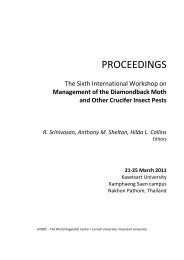Leguminous Vegetable Cultivation and Seed Production S ...
Leguminous Vegetable Cultivation and Seed Production S ...
Leguminous Vegetable Cultivation and Seed Production S ...
You also want an ePaper? Increase the reach of your titles
YUMPU automatically turns print PDFs into web optimized ePapers that Google loves.
<strong>Seed</strong> <strong>Production</strong> Technology of Beans<br />
There are 18 types of beans found throughout the world. Of these, French bean (Phaselous<br />
vulgaris L.) lablab beans (Labial) purpureus), cowpea (Vigna sinensis Savi) <strong>and</strong> cluster bean<br />
(Cno ir &y /n /uboI.. Taub. ) are very common <strong>and</strong> popularly consumed as green<br />
vegetable in India. Except for cluster bean, the seed of the other three beans is also consumed as<br />
pulse.<br />
All these crops are self-pollinated <strong>and</strong> exhibit very little heterosis. Also because of the less<br />
number of seeds available in the pods economical commercial hybrid seed production is not<br />
possible. Hybrids can be made by h<strong>and</strong> emasculation <strong>and</strong> pollination only 1odevxlope a variety <strong>and</strong><br />
for other improvements in the crop. The crops need 50-10 m isolation distance to produce<br />
foundation <strong>and</strong> certified seeds of two cultivars.<br />
French bean<br />
French bean is grown throughout the world as a green vegetable as well as for dry seed<br />
consumption as pulse. It is a self-pollinated crop with only 2-8% outcrossing.<br />
Climate French bean is uvvaoo-aeugoo crop in the hills but it does not thrive well under<br />
extremely high temperature. It cannot withst<strong>and</strong> drought as well as very heavy rainfall <strong>and</strong> frost.<br />
Even though, muoyculLivars are photo-insensitive, certain cultivars develop floral buds only<br />
during short days but would abscise during long days. Suitable soil temperature for good <strong>and</strong> rapid<br />
germination is 00C. Soil temperature ranging from 18 to 270C induce Rhizoctonia solani<br />
infection in young seedlings. High temperature exceeding 240C for two successive days can cause<br />
ureduction of 2% in the podsqt for each degree of temperature above 240C to 360F ( Davis 1945 ) .<br />
SburnmaeLul. (1983) found that 14-190C temperature <strong>and</strong> 60-70% humidity in autumn season <strong>and</strong><br />
20-250C <strong>and</strong> 50-70% humidity in spring season ared suitable for better growth <strong>and</strong> yield.<br />
Techniques for seed production French bean can be grown successfully in s<strong>and</strong>y loam<br />
soils. Alkaline <strong>and</strong> acidic soils should be avoided. To raise a good crop use 15-20 t FYM, 20 kg<br />
nitrogen, 60 kg phosphorous, <strong>and</strong> 60 kg potash. Except for nitrogen, other fertilizers should be<br />
mixed in the soil at the time of last plowing.<br />
Before sowing make sure that the soil contains sufficient moisture to attain better <strong>and</strong><br />
quicker germination. Watering just after sowing or before germination results in germination<br />
failure. <strong>Seed</strong>s take 6 to 7 days at I50C soil temperature to germinate, germination is delayed at<br />
temperature below 150C.<br />
Sow seeds of dwarf types at a distance of 45-60 cm in rows; plant-to-plant distance should<br />
be kept at 15-20 cm. Pole types require 90-I00 cm distance between rows <strong>and</strong> 30-40 cm between<br />
plants. Nearly 50-55 kg seed for pole type <strong>and</strong> 75-100 kg seed for bush type are required to sow<br />
one hectare of l<strong>and</strong>.<br />
Apply light irrigation <strong>and</strong> perform weeding <strong>and</strong> spraying of insecticide as <strong>and</strong> when<br />
required. Harvest ripe pods by h<strong>and</strong>. Dry the pods in the sun <strong>and</strong> thresh by beating with a stick. If<br />
plants are uprooted then curing must be done at least for 1 week so that pod color turns yellowish.<br />
Remove rotten <strong>and</strong> broken seeds at seed grading. After proper drying, keep the seed in store.<br />
Cowpea (Vigna<br />
oimuasio L.)<br />
Cowpea is grown throughout India for its long pods as green vegetable, seed as pulse, <strong>and</strong><br />
foliage as fodder. When grown for dry seeds, it is known as black eye pea, kaffier pea, China pea,<br />
or southern bean. The cultivars grown for their immature pods are variusly known as asparagus<br />
4
















